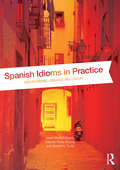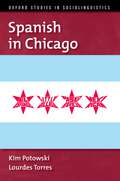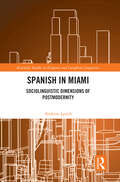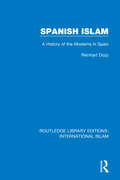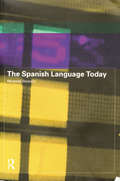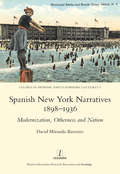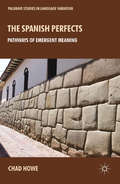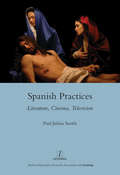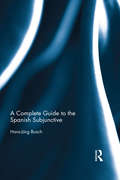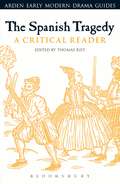- Table View
- List View
Spanish Idioms in Practice: Understanding Language and Culture
by Javier Muñoz-Basols Yolanda Pérez Sinusía Marianne DavidIdiomatic expressions are the ‘salt and pepper’ of any language. They give Spanish its colour and imagery, its richness and variety. From set phrases and idioms to metaphorical expressions and proverbs, these essential components allow users to add humour and spice to their language, vividly embodying Hispanic culture while naturalizing their communication style to more closely resemble that of native speakers. Key features: Includes a selection of the most widely used idioms from Spain and Latin America; Idioms are classified into specific and easy-to-reference categories; Creative activities, exercises, mnemonic devices and learning strategies facilitate the acquisition and mastery of idiomatic language; Connections between the Spanish language and Hispanic culture are explained and illustrated; Reference tables at the end of each section highlight similarities between English and Spanish usage of idiomatic language; Original samples, as well as fragments from various Spanish-speaking countries and well-known literary works, are included to help expose students to the use of idioms in journalistic and literary writing. Practical, informative and highly entertaining, this is the ideal text for all intermediate and advanced learners of Spanish.
Spanish in Chicago (OXFORD STUDIES SOCIOLINGUISTICS SERIES)
by Kim Potowski Lourdes TorresSpanish in Chicago is the first book-length study of Spanish in Chicago, where populations originating in both Mexico and Puerto Rico have lived in contact for generations and Latinos now comprise nearly a third of the population. Identifying Chicago as a rich site for examining language and dialect contact at both community and family levels, Kim Potowski and Lourdes Torres describe the spoken Spanish of Chicago, analyzing patterns of language change and identity constructions and establishing their likely causes. Drawing on interviews with 124 individuals across three generations of Mexican, Puerto Rican, and MexiRican Chicagoans, Potowski and Torres trace the effects of language and dialect contact through close sociolinguistic analysis of lexicon, discourse markers, codeswitching, the subjunctive, and phonology. Their analysis uniquely examines these features across three generations of speakers and two different regional origins within the same corpus. By including MexiRicans as a category, the book not only assesses the dynamics of linguistic convergence, dialect leveling, accommodation, and language loss, but also the concept of intrafamiliar dialect contact pioneered by Potowski. Contextualizing these language changes within the history of Latino communities in Chicago, Spanish in Chicago provides a nuanced picture of a minority language in a major US city and a vital contribution to sociolinguistics and Latino studies.
Spanish in Chicago (OXFORD STUDIES SOCIOLINGUISTICS SERIES)
by Kim Potowski Lourdes TorresSpanish in Chicago is the first book-length study of Spanish in Chicago, where populations originating in both Mexico and Puerto Rico have lived in contact for generations and Latinos now comprise nearly a third of the population. Identifying Chicago as a rich site for examining language and dialect contact at both community and family levels, Kim Potowski and Lourdes Torres describe the spoken Spanish of Chicago, analyzing patterns of language change and identity constructions and establishing their likely causes. Drawing on interviews with 124 individuals across three generations of Mexican, Puerto Rican, and MexiRican Chicagoans, Potowski and Torres trace the effects of language and dialect contact through close sociolinguistic analysis of lexicon, discourse markers, codeswitching, the subjunctive, and phonology. Their analysis uniquely examines these features across three generations of speakers and two different regional origins within the same corpus. By including MexiRicans as a category, the book not only assesses the dynamics of linguistic convergence, dialect leveling, accommodation, and language loss, but also the concept of intrafamiliar dialect contact pioneered by Potowski. Contextualizing these language changes within the history of Latino communities in Chicago, Spanish in Chicago provides a nuanced picture of a minority language in a major US city and a vital contribution to sociolinguistics and Latino studies.
Spanish in Miami: Sociolinguistic Dimensions of Postmodernity (Routledge Studies in Hispanic and Lusophone Linguistics)
by Andrew LynchSpanish in Miami reveals the multifaceted ways in which the language is ideologically rescaled and sociolinguistically reconfigured in this global city. This book approaches Miami’s sociolinguistic situation from language ideological and critical cultural perspectives, combining extensive survey data with two decades of observations, interviews, and conversations with Spanish speakers from all sectors of the city. Tracing the advent of postmodernity in sociolinguistic terms, separate chapters analyze the changing ideological representation of Spanish in mass media during the late 20th century, its paradoxical (dis)continuity in the city’s social life, the political and economic dimensions of the Miami/Havana divide, the boundaries of language through the perceptual lens of Anglicisms, and the potential of South Florida—as part of the Caribbean—to inform our understanding of the highly complex present and future of Spanish in the United States. Spanish in Miami will be of interest to advanced students and researchers of Spanish, Sociolinguistics, and Latino Studies.
Spanish in Miami: Sociolinguistic Dimensions of Postmodernity (Routledge Studies in Hispanic and Lusophone Linguistics)
by Andrew LynchSpanish in Miami reveals the multifaceted ways in which the language is ideologically rescaled and sociolinguistically reconfigured in this global city. This book approaches Miami’s sociolinguistic situation from language ideological and critical cultural perspectives, combining extensive survey data with two decades of observations, interviews, and conversations with Spanish speakers from all sectors of the city. Tracing the advent of postmodernity in sociolinguistic terms, separate chapters analyze the changing ideological representation of Spanish in mass media during the late 20th century, its paradoxical (dis)continuity in the city’s social life, the political and economic dimensions of the Miami/Havana divide, the boundaries of language through the perceptual lens of Anglicisms, and the potential of South Florida—as part of the Caribbean—to inform our understanding of the highly complex present and future of Spanish in the United States. Spanish in Miami will be of interest to advanced students and researchers of Spanish, Sociolinguistics, and Latino Studies.
Spanish in New York: Language Contact, Dialectal Leveling, and Structural Continuity (Oxford Studies in Sociolinguistics)
by Ricardo Otheguy Ana Celia ZentellaSpanish in New York is a groundbreaking sociolinguistic analysis of immigrant bilingualism in a U.S. setting. Drawing on one of the largest corpora of spoken Spanish ever assembled for a single city, Otheguy and Zentella demonstrate the extent to which the language of Latinos in New York City represents a continuation of structural variation as it is found in Latin America, as well as the extent to which Spanish has evolved in New York City. Their study, which focuses on language contact, dialectal leveling, and structural continuity, carefully distinguishes between the influence of English and the mutual influences of forms of Spanish with roots in different parts of Latin America. Taking variationist sociolinguistics as its guiding paradigm, the book compares the Spanish of New Yorkers born in Latin America with that of those born in New York City. Findings are grounded in a comparative analysis of 140 sociolinguistic interviews of speakers with origins in Colombia, Cuba, Dominican Republic, Ecuador, Mexico and Puerto Rico. Quantitative analysis (correlations, anovas, variable hierarchies, constraint hierarchies) reveals the effect on the use of subject personal pronouns of the speaker's gender, immigrant generation, years spent in New York, and amount of exposure to English and to varieties of Spanish. In addition to these speaker factors, structural and communicative variables, including the person and tense of the verb and its referential status, have a significant impact on pronominal usage in New York City.
Spanish in the USA: Linguistic, translational and cultural aspects
by Roberto ValdeónDelving into the uneasy relationship between English and Spanish in the United States of America, this book approaches specific topics from a variety of perspectives, ranging from the more cultural to the more linguistic. The contributions explore the problems arising in Puerto Rico as a consequence of the unique political status of the island; the linguistic peculiarities of codeswitching, and its use in legal and medical contexts where interpreting is necessary and in educational contexts with heritage language students; the (non)use and the ideological implications of translation in colonial museums; the connections between language, ethnicity and gender identities in the South West; and the role played by the Hispanic press in promoting intercultural dialogue in the New York City area. Engaging with previous publications, the book examines these topics from an interdisciplinary standpoint, offers new insights into the problems of this cultural and linguistic contact, and suggests new areas of research. This book was originally published as a special issue of Language and Intercultural Communication.
Spanish in the USA: Linguistic, translational and cultural aspects
by Roberto A. ValdeónDelving into the uneasy relationship between English and Spanish in the United States of America, this book approaches specific topics from a variety of perspectives, ranging from the more cultural to the more linguistic. The contributions explore the problems arising in Puerto Rico as a consequence of the unique political status of the island; the linguistic peculiarities of codeswitching, and its use in legal and medical contexts where interpreting is necessary and in educational contexts with heritage language students; the (non)use and the ideological implications of translation in colonial museums; the connections between language, ethnicity and gender identities in the South West; and the role played by the Hispanic press in promoting intercultural dialogue in the New York City area. Engaging with previous publications, the book examines these topics from an interdisciplinary standpoint, offers new insights into the problems of this cultural and linguistic contact, and suggests new areas of research. This book was originally published as a special issue of Language and Intercultural Communication.
Spanish Islam: A History of the Moslems in Spain (Routledge Library Editions: International Islam #1)
by Reinhart DozyOriginally published in 1913, this book contains the English translation of Reinhardt’s Dozy’s notable work, Histoire des Musalman’s d’Espagne. First published in 1861, this comprehensive work chronicles the extensive history of Islam in Spain. The introduction by the translator provides a useful overview of Reinhardt’s Dozy’s life and career. This comprehensive work will be of interest to those studying the history of Islam and Spain.
Spanish Islam: A History of the Moslems in Spain (Routledge Library Editions: International Islam #1)
by Reinhart DozyOriginally published in 1913, this book contains the English translation of Reinhardt’s Dozy’s notable work, Histoire des Musalman’s d’Espagne. First published in 1861, this comprehensive work chronicles the extensive history of Islam in Spain. The introduction by the translator provides a useful overview of Reinhardt’s Dozy’s life and career. This comprehensive work will be of interest to those studying the history of Islam and Spain.
The Spanish Language Today
by Miranda StewartThe Spanish Language Today describes the varied and changing Spanish language at the end of the twentieth century. Suitable for introductory level upward, this book examines:* where Spanish is spoken on a global scale* the status of Spanish within the realms of politics, education and media* the standardisation of Spanish* specific areas of linguistic variation and change* how other languages and dialects spoken in the same areas affect the Spanish language* whether new technologies are an opportunity or a threat to the Spanish language.The Spanish Language Today contains numerous extracts from contemporary press and literary sources, a glossary of technical terms and selected translations.
The Spanish Language Today
by Miranda StewartThe Spanish Language Today describes the varied and changing Spanish language at the end of the twentieth century. Suitable for introductory level upward, this book examines:* where Spanish is spoken on a global scale* the status of Spanish within the realms of politics, education and media* the standardisation of Spanish* specific areas of linguistic variation and change* how other languages and dialects spoken in the same areas affect the Spanish language* whether new technologies are an opportunity or a threat to the Spanish language.The Spanish Language Today contains numerous extracts from contemporary press and literary sources, a glossary of technical terms and selected translations.
Spanish New York Narratives 1898-1936: Modernization, Otherness and Nation
by David Miranda-BarreiroIn the early decades of the twentieth century, New York caught the attention of Spanish writers. Many of them visited the city and returned to tell their experience in the form of a literary text. That is the case of Pruebas de Nueva York (1927) by Jose Moreno Villa (1887-1955), El crisol de las razas (1929) by Teresa de Escoriaza (1891-1968), Anticipolis (1931) by Luis de Oteyza (1883-1961) and La ciudad automatica (1932) by Julio Camba (1882-1962). In tune with similar representations in other European works, the image of New York given in these texts reflects the tensions and anxieties generated by the modernisation embodied by the United States. These authors project onto New York their concerns and expectations about issues of class, gender and ethnicity that were debated at the time, in the context of the crisis of Spanish national identity triggered by the end of the empire in 1898.
Spanish New York Narratives 1898-1936: Modernization, Otherness and Nation
by David Miranda-BarreiroIn the early decades of the twentieth century, New York caught the attention of Spanish writers. Many of them visited the city and returned to tell their experience in the form of a literary text. That is the case of Pruebas de Nueva York (1927) by Jose Moreno Villa (1887-1955), El crisol de las razas (1929) by Teresa de Escoriaza (1891-1968), Anticipolis (1931) by Luis de Oteyza (1883-1961) and La ciudad automatica (1932) by Julio Camba (1882-1962). In tune with similar representations in other European works, the image of New York given in these texts reflects the tensions and anxieties generated by the modernisation embodied by the United States. These authors project onto New York their concerns and expectations about issues of class, gender and ethnicity that were debated at the time, in the context of the crisis of Spanish national identity triggered by the end of the empire in 1898.
The Spanish Perfects: Pathways of Emergent Meaning (Palgrave Studies in Language Variation)
by L. HoweThis book considers the role of cross-dialectal data in our understanding of linguistic variability, focusing on the widely discussed dichotomy between past tense forms and relying primarily on spoken language data from different varieties of Spanish.
Spanish Practices: Literature, Cinema, Television
by Paul Julian Smith"This book is the first to explore the interaction of three media in contemporary Spain. Focusing on some of the best known and most important books, feature films, and television series in the country (including novelist Antonio Munoz Molina, director Pedro Almodovar, and the Spanish version of telenovela Ugly Betty), it addresses three pairs of linked issues central to Hispanic studies and beyond: history and memory, authority and society, and genre and transitivity. Much of the material is very recent and thus as yet unstudied. The book also focuses on the representation of gender, sexuality, and transnationalism in these texts. Drawing on approaches from both the humanities and social sciences it combines close readings of key texts with the analysis of production processes, media institutions, audiences, and reception."
Spanish Practices: Literature, Cinema, Television
by Paul Julian Smith"This book is the first to explore the interaction of three media in contemporary Spain. Focusing on some of the best known and most important books, feature films, and television series in the country (including novelist Antonio Munoz Molina, director Pedro Almodovar, and the Spanish version of telenovela Ugly Betty), it addresses three pairs of linked issues central to Hispanic studies and beyond: history and memory, authority and society, and genre and transitivity. Much of the material is very recent and thus as yet unstudied. The book also focuses on the representation of gender, sexuality, and transnationalism in these texts. Drawing on approaches from both the humanities and social sciences it combines close readings of key texts with the analysis of production processes, media institutions, audiences, and reception."
Spanish Pragmatics
by M. Placencia Rosina Márquez ReiterThe first substantial textbook on pragmatics to focus on Spanish. The authors discuss key theories within the Anglo-American tradition of pragmatics, concentrating on the relationship between language use and socio-cultural contexts, and their uptake by Hispanists. Drawing on research by foremost scholars in the field, with reference to a wide range of 'Spanishes', including a first treatment of 'sociopragmatic variation'. Concepts throughout are illustrated with real language examples taken from different Spanish corpora. The book is carefully structured to be appropriate for upper-level undergraduate, as well as postgraduate, students.
The Spanish-Speaking World: A Practical Introduction to Sociolinguistic Issues (Routledge Language in Society)
by Clare Mar-MolineroThis accessible textbook offers students the opportunity to explore for themselves a wide range of sociolinguistic issues relating to the Spanish language and its role in societies around the world. It is written for undergraduate students who have a sound practical knowledge of Spanish but who have little or no knowledge of linguistics or sociolinguistics. It combines text with practical exercises and discussion questions to stimulate readers to think for themselves and to tackle specific problems.In Part One Clare Mar-Molinero discusses the position of Spanish as a world language, giving an historical account of its development and dominance. Part Two examines social and regional variation in Spanish, and investigates dialects, language attitudes, and style and register, particulaly in the media. The author also questions the relationship between gender and language. Part Three focuses on current issues, particularly those arising from language policies and legislation, especially in the education system, in Spain, Latin America and the USA.
The Spanish-Speaking World: A Practical Introduction to Sociolinguistic Issues (Routledge Language in Society)
by Clare Mar-MolineroThis accessible textbook offers students the opportunity to explore for themselves a wide range of sociolinguistic issues relating to the Spanish language and its role in societies around the world. It is written for undergraduate students who have a sound practical knowledge of Spanish but who have little or no knowledge of linguistics or sociolinguistics. It combines text with practical exercises and discussion questions to stimulate readers to think for themselves and to tackle specific problems.In Part One Clare Mar-Molinero discusses the position of Spanish as a world language, giving an historical account of its development and dominance. Part Two examines social and regional variation in Spanish, and investigates dialects, language attitudes, and style and register, particulaly in the media. The author also questions the relationship between gender and language. Part Three focuses on current issues, particularly those arising from language policies and legislation, especially in the education system, in Spain, Latin America and the USA.
The Spanish Subjunctive: A Reference for Teachers
by Hans-Jorg BuschA Complete Guide to the Spanish Subjunctive is the most complete reference guide to the use of the subjunctive in Spanish. Along with an exhaustive review of published literature on the subjunctive, the book also includes a thorough discussion of the uses and meanings of the subjunctive as well as examples throughout drawn from linguistic corpora such as the CREA database. The book presents a comprehensive theory of the subjunctive and provides practical rules for understanding, teaching and acquiring the Spanish subjunctive. This book includes: "Your Turn" sections that invite readers to reflect on the content discussed and on their own experiences in teaching the subjunctive A "Synopsis" section that summarizes the content of the work and offers practical suggestions for teaching the subjunctive Two indexes providing a summary of verb conjugation in the subjunctive and an alphabetical list of expressions used with the subjunctive.
The Spanish Subjunctive: A Reference for Teachers
by Hans-Jorg BuschA Complete Guide to the Spanish Subjunctive is the most complete reference guide to the use of the subjunctive in Spanish. Along with an exhaustive review of published literature on the subjunctive, the book also includes a thorough discussion of the uses and meanings of the subjunctive as well as examples throughout drawn from linguistic corpora such as the CREA database. The book presents a comprehensive theory of the subjunctive and provides practical rules for understanding, teaching and acquiring the Spanish subjunctive. This book includes: "Your Turn" sections that invite readers to reflect on the content discussed and on their own experiences in teaching the subjunctive A "Synopsis" section that summarizes the content of the work and offers practical suggestions for teaching the subjunctive Two indexes providing a summary of verb conjugation in the subjunctive and an alphabetical list of expressions used with the subjunctive.
The Spanish Tragedy: A Critical Reader (Arden Early Modern Drama Guides)
by Thomas RistThe Spanish Tragedy was the first 'revenge tragedy' on the English Renaissance stage: but for its influence, major dramas including The Revenger's Tragedy, The Duchess of Malfi and even Hamlet would not exist as they do. It is thus a key text for the study of Renaissance drama and normally appears in introductory undergraduate courses on Renaissance drama and Shakespeare. Despite its initial smash-hit status, after the closing of the theatres in 1642 the play was only once performed in Britain before its gradual revival in the 20th century. Following its first professional performance in 1973, the play has come to be recognised as a Renaissance classic, receiving frequent performance. This volume will bring together its most insightful and influential modern scholars to produce an edition read both by experts in the field and lovers of Thomas Kyd's drama.
The Spanish Tragedy: A Critical Reader (Arden Early Modern Drama Guides)
by Thomas RistThe Spanish Tragedy was the first 'revenge tragedy' on the English Renaissance stage: but for its influence, major dramas including The Revenger's Tragedy, The Duchess of Malfi and even Hamlet would not exist as they do. It is thus a key text for the study of Renaissance drama and normally appears in introductory undergraduate courses on Renaissance drama and Shakespeare. Despite its initial smash-hit status, after the closing of the theatres in 1642 the play was only once performed in Britain before its gradual revival in the 20th century. Following its first professional performance in 1973, the play has come to be recognised as a Renaissance classic, receiving frequent performance. This volume will bring together its most insightful and influential modern scholars to produce an edition read both by experts in the field and lovers of Thomas Kyd's drama.
Spanish Vampire Fiction since 1900: Blood Relations (Routledge Studies in Comparative Literature)
by Abigail Lee SixSpanish Vampire Fiction since 1900: Blood Relations, as that subtitle suggests, makes the case for considering Spanish vampire fiction an index of the complex relationship between intercultural phenomena and the specifics of a time, place, and author. Supernatural beings that drink blood are found in folklore worldwide, Spain included, and writers ranging from the most canonical to the most marginal have written vampire stories, Spanish ones included too. When they do, they choose between various strategies of characterization or blend different ones together. How much will they draw on conventions of the transnational corpus? Are their vampires to be local or foreign; alluring or repulsive; pitiable or pure evil, for instance? Decisions like these determine the messages texts carry and, when made by Spanish authors, may reveal aspects of their culture with striking candidness, perhaps because the fantasy premise seems to give the false sense of security that this is harmless escapism and, since metaphorical meaning is implicit, it is open to argument and, if necessary, denial. Part I gives a chronological text-by-text appreciation of all the texts included in this volume, many of them little known even to Hispanists and few if any to non-Spanish Gothic scholars. It also provides a plot summary and brief background on the author of each. These entries are free-standing and designed to be consulted for reference or read together to give a sense of the evolution of the paradigm since 1900. Part II considers the corpus comparatively, first with regard to its relationship to folklore and religion and then contagion and transmission. Spanish Vampire Fiction since 1900: Blood Relations will be of interest to Anglophone Gothic scholars who want to develop their knowledge of the Spanish dimension of the mode and to Hispanists who want to look at some canonical texts and authors from a new perspective but also gain an awareness of some interesting and decidedly non-canonical material.
